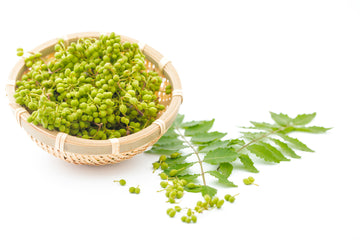Sansho, known as the oldest spice in Japan, is characterized by its sharp spiciness and refreshing aroma similar to citrus fruits. The spiciness of sansho not only adds depth to the flavor of dishes, but it has also been used as a natural medicine. What kind of spicy ingredients are contained in sansho, which has been loved by the Japanese since ancient times?
■What is the main spicy component of Japanese pepper?
All parts of the Japanese pepper plant, including not only the fruit but also the flowers and leaves, can be used as a spice, but the spicy ingredients are mainly found in the fruit.

The spiciness of Japanese pepper is mainly due to sanshool and sanshoamide. Currently, about 250 species of Zanthoxylum genus plants of the Rutaceae family have been identified around the world, and sanshool, an unsaturated fatty acid amide, is a component contained in these plants, and is found most abundantly in unripe green Japanese pepper.
The name sanshool comes from adding the suffix "-ol" (all), which refers to alcohol, to Japanese pepper. There are several analogues of sanshool, such as α-sanshool and β-sanshool. In particular, hydroxy-α-sanshool, which is contained in Japanese pepper from Sichuan Province, China, is a powerful component of sanshool, activating certain nerve fibers in the mouth and causing a tingling, numbing sensation.
-What are the effects of the spicy components in Japanese pepper?
Usually, sweetness and sourness are sensed by the taste nerves, but spiciness is not sensed by the taste nerves, but by the sensory nerves as a stimulus. Therefore, strictly speaking, the spiciness of Japanese pepper is not a "taste." Also, there are two types of spiciness: heat-resistant non-volatile and heat-sensitive volatile. The spiciness of Japanese pepper is heat-resistant and long-lasting, so it belongs to the non-volatile type.
Sansho has been used as a herbal medicine in traditional Chinese medicines such as Daikenchuto and Shobaito. Sanshool and sanshoamide, the spicy components of Sansho, activate the internal organs, and are expected to improve indigestion, relieve chills, and relieve stomach pain caused by gas buildup. It is also said to have a sweating effect and stimulate metabolism.
■ The unique spiciness of Japanese pepper
There are many different types of spiciness, but the spicy components of Japanese pepper are different from those of chili peppers and peppers. Here, we will introduce how Japanese pepper differs from chili peppers in spiciness and how to reduce the spiciness of Japanese pepper.
・The spiciness of Japanese pepper is different from that of chili peppers. The main spiciness components of Japanese pepper are sanshool and sanshoamide, while the spiciness component of chili peppers is capsaicin. Both sanshool and capsaicin are fat-soluble components, so they do not dissolve in water. In addition, Japanese pepper and chili peppers have the same non-volatile spiciness.
Although they have these commonalities, when comparing their molecular structures, the differences become clear: Capsaicin, a vanilloid, contains a vanillyl group, whereas sanshool does not.
In the case of capsaicin, the vanillyl group binds to the ionotropic receptor TRPV1, causing a burning pain. However, sanshool does not have a vanillyl group, so it does not have a burning hot spiciness. Rather, sanshool acts like an anesthetic, giving you a numbing spiciness, so there is a big difference in the sensation of spiciness between chili peppers and Japanese pepper.
Even more interesting, capsaicin activates neurons that detect unpleasant stimuli and pain, whereas hydroxy-α-sanshool activates neurons that detect harmless stimuli, such as gentle touch.

How to reduce the spiciness of Japanese pepper The spiciness of Japanese pepper brings a refreshing feeling, but some people don't like it. Some people try to get rid of the spiciness by drinking water, but since the spiciness of Japanese pepper is not water-soluble, the spiciness does not go away easily even if you drink water.
Unlike wasabi, which has a water-soluble spiciness, the spiciness of sansho is fat-soluble. Therefore, you can reduce the spiciness by dissolving it in oil instead of water. We recommend ice cream or mayonnaise. If you want to get rid of the unique spiciness of sansho, putting ice cream or mayonnaise in your mouth will help to reduce the spiciness.
Click here to purchase.
Yamamoto Katsunosuke Shoten, a Kishu Sansho specialty store founded in 1880 in Wakayama Prefecture
